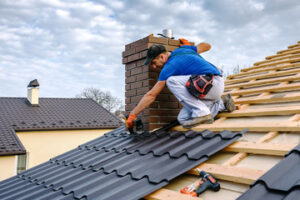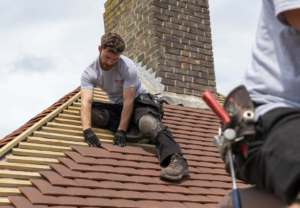Columbus Roof Repair focuses on fixing specific components of your roof such as pipe boots, flashing, and shingles. It can help to prolong the life of your roof.

Even though shingles and tiles are designed to withstand a lot of wear and tear, they’re not infallible. Significant damage from storms can cause leaks and structural issues that require replacement.
Shingles and tiles are incredibly durable and built to withstand a lot of wear and tear. That said, they aren’t infallible and it is common for high winds or hail to damage them. In these cases, the damaged shingles or tiles will need to be replaced. The good news is that these repairs are relatively simple and inexpensive.
The first step is to locate the damaged shingle or tile. To do this, carefully walk around the perimeter of your roof and look for any shingle that has been lost or pulled up from the surface of the roof. This is a sign of shingle failure and should be treated as a priority.
Once you’ve found the damaged shingle, use your pry bar to loosen the nails that secure it. Start by sliding the pry bar under the shingle and working it upward. Once the nail pops up a little, remove the pry bar, press down on the shingle and pull out the nails. Continue to do this all the way around the shingle until it is completely removed.
If you notice any water stains on your ceilings or walls, this is another indication that the shingles have failed and may be leaking into the house. It’s also important to look for shingles that are cracked or blistering. These can lead to further problems and may cause leaks if not addressed.
Replacing a single tile is easy enough, but it’s a different story when you have to replace a whole section of the roof. In this case, you’ll have to match the exact color and style of your existing shingles to get the job done right. While this is a fairly simple task, it’s often best left to professionals who can ensure that the new sections of your roof will fit perfectly and won’t look like a sore thumb. They can also ensure that any cracked and leaking areas are properly sealed. This is an especially important step when replacing shingles and tiles near chimneys, skylights or vents. These areas tend to see more damage than other parts of the roof and should be treated with extra care.
Flashing
Many elements of construction go unnoticed, but they often perform critical tasks. Roof flashing is one of these unsung heroes, as it prevents leaks and water damage by sealing the seams and joints around structures like chimneys, vents, skylights and more. However, flashing can be damaged by a number of factors, making it important to know how to recognize and repair flashing problems quickly.
Common causes of flashing problems include corrosion and rust, cracks or holes in the surface, looseness of the material, or improper installation. These issues can lead to the creation of a path for water infiltration and ultimately compromise the integrity of your home’s roofing system.
A flashing repair expert can help you determine the best course of action for repairing or replacing your flashing. If the flashing is still intact, but a hole or crack has developed, it may be possible to patch the area with roof caulk. However, this is a temporary solution and should not be relied on for long-term protection.
If the flashing has become loose or detached, it may need to be replaced entirely. This is usually the case when metal flashing has corroded due to prolonged exposure to weather conditions. It’s important to replace the flashing with the same type and material in order to ensure a secure seal.
Another way to prevent damage to flashing is to perform regular inspections. You can do this during the spring and fall, or after severe weather events that may impact your roof, such as hail or wind.
To do a flashing inspection, you should carefully remove any shingles that cover the flashing to expose the area beneath them. Then, you can carefully cut a new piece of flashing to fit, and then secure it in place using roofing nails or screws. Be sure to overlap the new flashing with the existing material to create a watertight seal. There are several types of flashing available, including step, counter and continuous flashings. Each has a specific purpose, so make sure you’re using the right kind of flashing for your home.
Leaks
Leaking roofs cause rot, mold growth, water damage to ceilings and walls, and other home systems. It’s crucial to identify and repair leaks promptly so they don’t spread. Often, the source of a leak is obvious, such as missing or broken shingles, improperly sealed flashing around chimneys, skylights and vents, or damaged valleys. Other times, the problem is less straightforward and may be caused by damaged gutters or a clogged downspout.
To locate a leak, start by looking for water spots on your ceiling. These stains are usually caused by leaking roof water that seeps through the surface, soaking the drywall or plaster below. You can also look for sagging areas in the ceiling that are protruding from the structure of your home. Leaking roofs can also cause a damp, musty smell in the rooms below.
If you suspect a leak, get a ladder and carefully walk around your roof to look for the source of the problem. Depending on the type of roofing, you might have to remove a section of the roof membrane and inspect the underneath for signs of rot or discoloration. A flat roof is typically covered with a layer of EPDM rubber, while older built-up roofs are lined with layers of tar paper.
Once you’ve located the source of a leak, use a garden hose to spray water over the area. Keep in mind that the direction of the water flow will indicate which side of the roof you’ll need to clean and repair.
You can also check for signs of a leak by taking a flashlight into your attic and shining it along the edges of the insulation. If the flashlight reveals shiny or wet spots, there’s likely a leak. You should also check around the attic rafters for dark mold or rotting wood and look under roof vents, skylights, chimneys, dormers and roof-pitch transition points. The best way to prevent a leaky roof is to perform routine maintenance, including regular inspections and repairs. A proactive approach to roof repairs preserves your investment and protects the value of your home.
Curb Appeal
When people talk about “curb appeal” on home improvement shows or in real estate advertising, they’re referring to how attractive a house looks to those who are viewing it from the outside. This includes the yard, driveway, and sidewalks as well as the roof and exterior paint. A new roof is a great way to increase the curb appeal of any property, and it can also help boost its value.
Several factors contribute to curb appeal, and they can include simple landscaping, regularly cleaning gutters, and painting the front door and shutters. But a new or repaired roof is one of the most important elements, since it covers such a large area. It instantly transforms the look of a house and can make it appear more attractive and well-maintained, which in turn attracts buyers.
A new roof can also improve a property’s value, which can be significant when the time comes to sell it. Studies have found that curb appeal increases a home’s perceived value by 5-11%, and this can translate to thousands of dollars in additional sales price.
Besides making a house more attractive, a new roof can also protect it from damage and increase its longevity. A damaged or weathered roof, on the other hand, can reduce a house’s durability and may even require costly repairs in the future.
Curb appeal also plays a role in establishing a buyer’s expectations about the interior of a home. If the outside appears clean, attractive, and well-maintained, a potential buyer will assume that the inside is the same. This is known as the halo effect, and it can help sell a home faster and for a higher price than a less-attractive property.
The importance of a good-looking roof cannot be overstated. It’s a key element that influences the overall appearance of a building and sets the tone for how it will be maintained in the future. In addition, a well-maintained and attractive roof provides assurances that the structure is sound, which in turn helps increase its saleability. In today’s competitive real estate market, an attractive roof can add a significant amount of value to any property.
